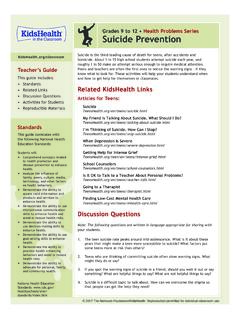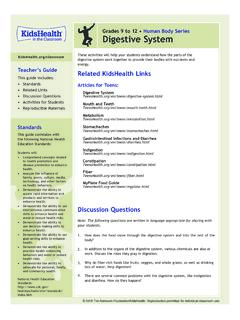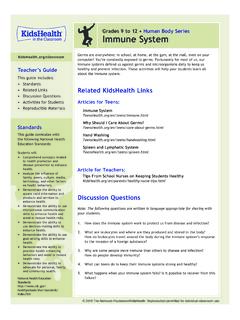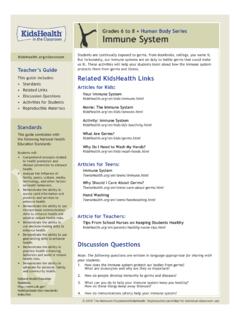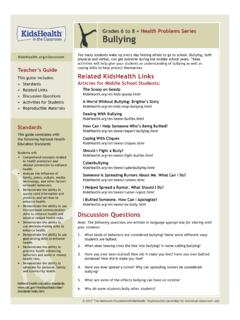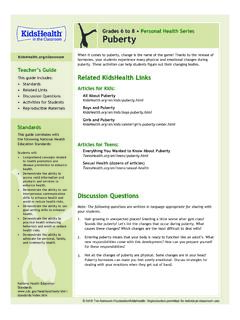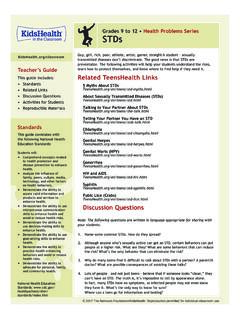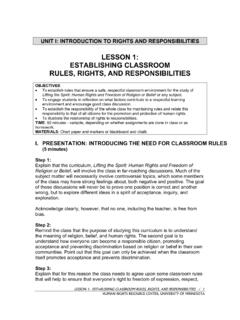Transcription of Teacher's Guide: Empathy (PreK to Grade 2)
1 K to Grade 2 Personal Health Series Empathy Showing Empathy is an important part of being a friend and getting along with people. It means you can think about and understand how other people are feeling. These activities will help your students understand how to describe their own Teacher's Guide feelings and how to be supportive of each other. This guide includes: Standards Related KidsHealth Links Related Links Discussion Questions Articles for Kids: Activities for Students Talking About Your Feelings Reproducible Materials How Cliques Make Kids Feel Left Out Standards This guide correlates with The Scoop on Gossip the following National Health Education Standards: How Do I Help a Kid Who's Bullied?
2 Students will: Demonstrate the ability to use interpersonal communication Someone in My Friend's Family Died: What Should I Do? skills to enhance health and avoid or reduce health risks. Demonstrate the ability to use decision-making skills to Saying You're Sorry enhance health. Demonstrate the ability to use goal-setting skills to enhance Getting Along With Teachers health. Demonstrate the ability to practice health-enhancing behaviors and avoid or reduce Getting Along With Parents health risks. Demonstrate the ability to advocate for personal, family, and community health.
3 Discussion Questions Note: The following questions are written in language appropriate for sharing with your students. 1. What kinds of things make you feel happy? Sad? Angry? Excited? How do you act when you feel these ways? Can you tell how your parents or your brothers or sisters or your friends are feeling? How? 2. How can you show a friend that you're really listening? What does careful listening look like? 3. How do you feel when somebody interrupts you? What do you do or say? National Health Education Standards: 4. If you found out a friend or classmate was feeling sad, what would you say?
4 How healthyschools/sher/standards/ would you help your friend or classmate feel better? 2016 The Nemours Foundation/KidsHealth. Reproduction permitted for individual classroom use. K to Grade 2 Personal Health Series Empathy Activities for Students Note: The following activities are written in language appropriate for sharing with your students. I Feel .. Objectives: Students will: Identify different feelings Identify and describe the nonverbal ways (body language) people show their feelings Materials: Art supplies (colored pencils, markers, crayons).
5 "I Feel " handout Class Time: 45 minutes Activity: People feel all kinds of different feelings: happy, sad, excited, nervous, scared, angry, lonely, confused, uncomfortable, surprised, shy, embarrassed, loved, and proud. Sometimes people talk about how they're feeling, and other times they might not say anything, but their faces and bodies and movements may show how they feel. Stand up, and make sure you have enough room to move without bumping into a classmate. I'll turn off the lights and say, Show how you look and how you move when you're happy.
6 As soon as the lights go on, make a face that shows how you feel when you're happy and move around in a happy way without talking. When the lights go off, freeze. I'll name another feeling and then turn on the lights again. Show your feeling through your facial expressions and your movements. After a few minutes, stop and talk about how you look and move for different feelings. How do you look and move when you're sad? When you're excited? When you're feeling shy? Now think about what happens that makes you feel certain feelings.
7 Write down your thoughts on the "I Feel ". handout. Share what you write with the class. Extensions: 1. Colors sometimes seem to match feelings. Which colors do you think seem happy? Sad? Angry? Excited? Do any colors overlap? Choose three colors and create a picture that shows how you feel. 2. How closely can you pay attention to someone's body language? Pair up with a partner. Decide who will be the leader and who will be the follower. The leader begins by making an expression (smile, frown) slowly enough so that the follower can "mirror" him or her.
8 Leaders, don't try to trick the followers you want them to follow you. Followers, play close attention to how the leaders move. What are their eyes doing? Their mouths? Their hands? Change roles and start over. 2016 The Nemours Foundation/KidsHealth. Reproduction permitted for individual classroom use. K to Grade 2 Personal Health Series Empathy How Would You Feel if . Objectives: Students will: Recognize the feelings and perspectives of others Role-play and brainstorm ways to respond to people depending on how they're feeling Materials: Puppet or stuffed animal "How Would You Feel if " handout Class Time: 30 minutes Activity: Getting along involves thinking about how other people are feeling.
9 When something happens, thinking about how you would feel in that situation can give you an idea about how someone else might feel. It's important to think about how other people might be feeling and what you can say and do to support them. You and two other classmates are going to role-play a few different situations from the "How Would You Feel if " handout. Role-play at least three of the situations. Then, share with the class some of the ways your group responded in the situations. Extensions: 1. What makes a good listener?
10 How can you tell when someone is listening carefully? Make a list describing what good listening looks and sounds like. 2. In small groups, toss around a beanbag or small ball. How could you encourage the other kids in your group? If the ball is dropped or missed, what could you say to be supportive? Reproducible Materials Handout: I Feel . Handout: How Would You Feel if . is devoted to providing the latest children's health information. The site, which is widely recommended by educators, libraries, and school associations, has received the Teachers' Choice Award for the Family and the prestigious Pirelli Award for Best Educational Media for Students.


